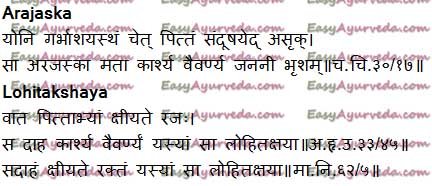Arajaska – Lohitakshaya Symptoms, Pathogenesis, Treatment, Remedies
By Dr Raghuram Y.S. MD (Ay) & Dr Manasa, B.A.M.S
Arajaska is one among the 20 gynaecological disorders caused by vitiated pitta and blood. While Master Charaka has named it as Arajask, both Vagbhatas have named it as Lohitakshaya. Both have similar presentations and meaning. Lohita is the synonym of rakta i.e. blood. Therefore this condition is also called as Raktakshaya. Read – Hypomenorrhoea: Causes, Remedies, Ayurvedic Treatment
Table of Contents
Arajaska Gynaecological Disorder
Pathogenesis – When pitta situated in vagina and uterus vitiates the blood located therein, they jointly contaminate the mentioned structures and cause a gynaecological disorder called arjaska. Read – Artava – Menstrual Blood Formation, Healthy Characteristic Features
Symptoms of Arajaskam –
- Karshya – emaciation
- Vaivarnyam – discoloration
- Anartava – amenorrhea (Chakrapani)
Meaning of Arajask is Na + Rajaska = No menstruation. Though Charaka has not mentioned as the main symptom, he has named the disease as Arajaska. Therefore amenorrhea should be inferred. Read – Heavy Periods, Menstrual Bleeding: Ayurvedic Treatment Clarification is given by commentator Chakrapani. Other symptoms i.e. emaciation and discoloration appears to be the effects of due to less blood leading to amenorrhea.
Lohitakshayam Gynaecological Disorder
According to both Vagbhatas, Lohitakshaya is a condition caused due to vitiation of vata and pitta. Due to the vitiation of vata and pitta, the raja i.e. menstrual blood is decreased. As a result the woman suffers from burning sensation, emaciation and discoloration. Read – Vatala Yoni Vyapad – Causes, Symptoms, Treatment
Other opinions –
According to Madhava Nidana and Yogaratnakara treatises, this condition called lohitakshaya is characterised with loss of blood and is associated with burning sensation. Other symptoms are those of pitta vitiation i.e. suppuration, fever etc. In Madhukosha commentary, cause of loss of blood is said to be excessive bleeding.
Sanskrit verse

Modern correlation and comparative study
Charaka has called this condition as arjaskam i.e. absence of menstrual blood. Vagbhata has called this condition as lohitakshaya i.e. loss of blood. Both these terms almost deliver the same meaning. When we club the Madhukosha explanation with those of Charaka and Vagbhata we get a comprehensive meaning, i.e. excessive bleeding (Madhukosha) leads to loss of blood (Vagbhata) which leads to absence of menstrual blood (Charaka). Read – Charaka Chikitsa Sthana 30th Chapter – Yoni Vyapat
Moreover it looks like all authors are talking about the same condition. While Vagbhata and Madhukosha are mentioning the cause, Charaka, in his definition has given the ultimate effect.
Though the etiology and name given by both Charaka and Vagbhata look different, the clinical features are the same i.e. loss or absence of menstrual blood.
Coming to aetiology, Charaka has mentioned pitta as the chief cause while Vagbhata has mentioned vitiated vata and pitta to be causative. Since both authors have accepted pitta, pitta is the chief dosha involved in the causation of this disorder. However, the role of vata cannot be neglected.
Lower portion of the body, including the functions of the reproductive system, in both men and women is governed by apana vata, a subtype of vata. Apana vata is responsible for the accumulation of blood in uterus and its excretion during menstruation. Obviously imbalance of apana vata should be responsible for loss of blood and absence of menstrual blood in the above said pathologies.
Read – Physiology Of Menstruation, Menstrual Cycle – Ayurvedic Perspective Vata vitiation can be considered as secondary to pitta vitiation and hence rightly mentioned by Vagbhata in the etio-pathogenesis of lohitakshay.
Since in this condition, along with amenorrhea, there is presence of other symptoms like marked emaciation, fever etc. Hence arjaska / lohitakshaya appear to be one of the below mentioned conditions –
- Secondary amenorrhea due to anaemia or tuberculosis, especially due to excessive bleeding or
- Any other systemic deficiency disorder.
Treatment of Arajaska / Lohitaksaya
Uttara basti with Kashmaryadi ghrita – Ghee should be prepared with Stereospermum suaveolens and Holarrhena antidysenterica. This ghee should be used for giving enema through vaginal route.
Rakta Uttara Basti – Blood of deer, goat, sheep and hog should be taken and mixed with sour substances, curds, honey and . The resultant mixture should be administered into uterus through vagina.
Ghrita pana – Woman should be made to drink the ghee processed with blood of deer, goat, sheep and hog, curds and juice of sour fruits.
Jeevaniya Ksheera – Woman should be given with milk processed with Jeevaniya group of herbs for drinking.
Click to Consult Dr Raghuram Y.S. MD (Ayu) – Email / Skype









